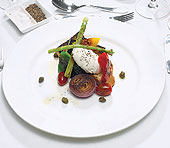 |
On most evenings Shaun Kenworthy saunters out of his kitchen at The Blue Potato, the first stand-alone fine dining restaurant in Calcutta, to chat with guests. As you tuck into a perfectly grilled sea bass that crumbles deliciously in your mouth, or slowly savour some pan-fried breast of duck with orange and cranberry reduction, chances are that the expat British chef will come up to your table and ask you about the food. Maybe he will suggest a particular dessert to finish off your meal — a mascarpone tart with figs in port wine, or perhaps an old-fashioned, but utterly sinful, sherry trifle.
Kenworthy has a reason for taking such a passionate interest in your gastronomic experience at The Blue Potato, and to make sure that you know your foie gras from your fricassee. He owns the place. And that makes this upscale eatery one of the few chef-owned free-standing restaurants in India that serves serious, top-end food to gourmets and gourmands alike.
Around the world, the most celebrated fine dining establishments are almost always owned by chefs. Whether it is the quirky and utterly brilliant Heston Blumenthal’s The Fat Duck in Berkshire, UK, or Charlie Trotter’s eponymous eatery in Chicago, or Gordon Ramsay’s three star Michelin outlet in London, the culinary hall of fame is studded with chef-owned and chef-driven restaurants. “In the West nobody would dream of going to a five star hotel for fine food,” says Kenworthy. Adds industrialist Dhruv Sawhney, a food and wine connoisseur, “You’d be hard put to find a Michelin-starred restaurant which is part of a big hotel’s operation.”
 |
 |
| TOP NOSH: Chefs Shaun Kenworthy and (top) Rahul Akerkar |
That’s because in most places around the world standard issue five star fare is simply no match for the clarity and creativity of top-flight chef-owned eateries. An owner chef not only has the passion and the enthusiasm to go that extra mile and raise the culinary bar; he not only invents and innovates, but he also has the domain expertise to set standards and maintain them. “He brings his passion and innovativeness to the table, puts his name on the menu, as it were. And that makes all the difference,” says wine consultant and foodie Sanjay Menon, owner of Sonarys Co-brands, India’s leading wine importer.
Ask Rahul Akerkar, the chef who owns Indigo, the culinary hotspot in Mumbai so beloved of the Page 3 crowd. In a chef-owned or a chef-driven environment, the food is bound to be superior, he asserts. “There is more attention to detail, attention to good, classical cooking techniques, attention to the use of fresh, seasonal ingredients,” he says. “The entire machine runs better — much like an automotive mechanic’s car that always sounds and runs better than others’ cars!”
Even in the sourcing of raw materials — so crucial to fine cuisine — a chef-driven establishment has an edge over restaurants in big hotels. In the latter, a chef may have to play second fiddle to the store manager who tends to be driven more by price than by quality. However, owner-chefs such as Kenworthy are free from such constraints. “Because I have full operational autonomy,” he says, “I don’t compromise on the quality of my ingredients.”
Neither does Ritu Dalmia, Delhi’s high priestess of Italian cuisine and owner of the fine dining outlet, Diva. “Being a chef, I can strike a balance between my creativity and practical problems,” she says. So she manages to maintain the quality of her products even while working around high food costs.
Of course, most luxury hotel chains insist that in their specialty restaurants at least, the cook is really the king. And that, they say, accounts for their excellence. “Our restaurants are totally chef-driven,” asserts Hemant Mehta, executive chef of Hyatt Regency, Calcutta. “The chef decides the menu, the ingredients, the cooking technique — everything. The restaurant manager merely gives his feedback,” he says.
But what of the fact that in a hotel, a chef may be transferred, or indeed, may quit? Does that not affect the food standards of a restaurant? For example, the Imperial Hotel in Delhi was without an executive chef for nearly a month until recently. But Mehta dismisses such things as minor blips in a big hotel’s operation. Besides, he says, a chef is rarely transferred if a restaurant is doing good business.
So are chef-owned res- taurants in India really stealing the show from fine dining outlets of, say, a Taj or an Oberoi, a Marriott or a Hyatt? Sadly, no. First of all, there are still too few of them. Hospitality industry watchers say that the problem boils down to finances. Creating a luxury fine dining restaurant is an expensive operation and not many stand-alones in India are able to muster up the huge funds required to sustain it. Though most of them have business partners — both Kenworthy and Dalmia do — it’s still a question of being able to pump in large amounts of money over a fairly long time.
Besides, fine dining, by its very definition, involves the pairing of fine food with fine wine. But few chef-owned restaurants in India — Indigo is a notable exception — can compete with the wine lists of restaurants in five star hotels. Thanks to their financial muscle, most hotels are able to build up bigger and better wine lists than stand-alones.
This is not to say, however, that big hotels are getting it right when it comes to pairing their food with wine. “Even in the best five star restaurants, there is no real effort to do serious pairing,” says Menon. “For instance, a Cabernet Sauvignon, a popular red wine variety, does not go even with moderately spiced Indian food. Yet you’ll find it on the wine lists of both western and Indian cuisine restaurants.”
Indeed, most hotels do not bother to have separate wine lists for Indian and western food. Mehta of the Hyatt admits that wine lists are, for the most part, supply driven. But here the government is to blame too as it makes the process of importing wines prohibitively expensive. Whether it is a Chablis or a Chardonnay, a Barolo or a Chianti, an Australian Shiraz or a fresh young Chilean, every label has to be registered with the excise department of the local government. The import duties are huge too. That’s a formidable deterrent — even for cash-rich five star hotels — to come up with suitably extensive and varied wine lists. So most hotels stick to the tried, the tested and the already available. After all, as Menon points out somewhat acidly, it doesn’t make sense to sink a lot of money on bringing in a wide variety of labels if a hotel is not too sure of selling them.
Naturally, small chef-owned establishments feel the pinch of the excise laws even more. “The excise laws really need to change in this country,” says Sawhney. “If putting together a good wine list continues to be so exorbitant, very few chef-owned restaurants will be able to aspire to the fine dining tag,” he adds. Kenworthy, for one, is still waiting to get some wines on his table, without which the concept of The Blue Potato as a fine dining experience remains incomplete.
But elsewhere in the world, chef-owned eateries dominate the gastronomic landscape so completely that many big hotels have begun to outsource their restaurants to celebrity chefs in an effort to fill their empty dining rooms. Examples of the trend abound. The Hotel Plaza Athéée in Paris has done it with acclaimed chef Alain Ducasse, The Berkeley in London has two Gordon Ramsay outlets, and the Four Seasons in New York has gone that way too.
Obviously, India has some catching up to do before chef-owned restaurants can become the gastronomic powerhouses they are in the West. Still, a beginning has been made. That’s enough to get Indian foodies to lick their chops and wait for a taste of culinary nirvana.











